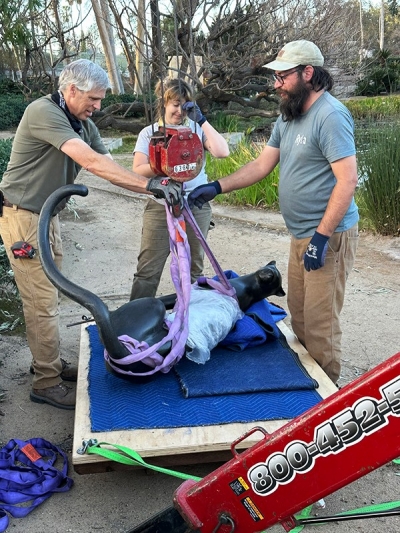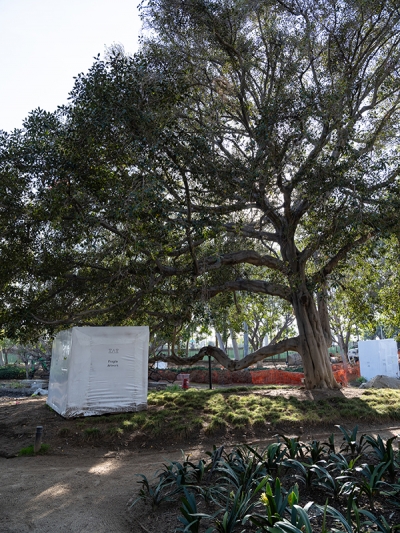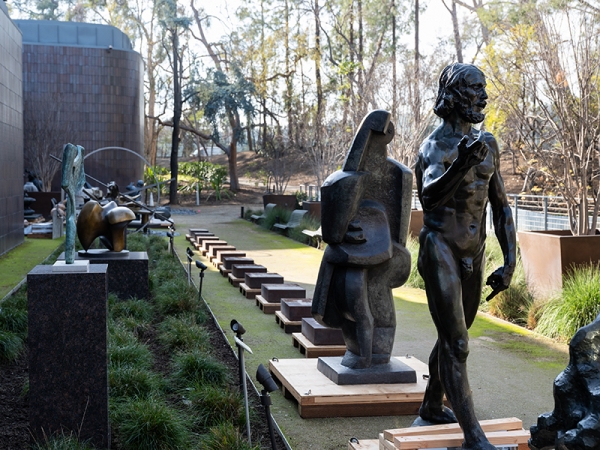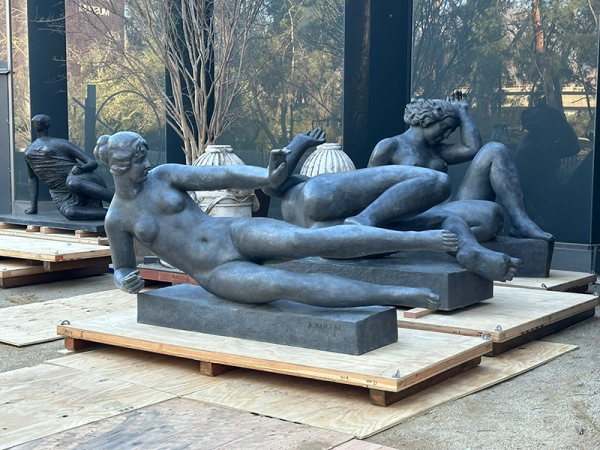Under Construction: Protecting Outdoor Sculpture

Steve Spargur, Loren Costa and Zulu Green of the Spartacus/Ryla team lifting Henry Moore's "Draped Reclining Woman" with a "spider" crane
One key aspect of the Exterior Improvement Project is the subtle reshaping of the Sculpture Garden terrain to improve drainage and irrigation. While the lush character of the garden and pond will stay true to landscape designer Nancy Goslee Power’s original vision, the area has necessarily been transformed into a bustling construction site. Our conservation and art preparations team has, since the early stages, provided expert advice on the needs of the outdoor sculpture collection to preservation architects Architectural Resources Group (ARG) as they developed the project design. Once the complex practical details were refined during ARG’s consultation with general contractor Morley Builders Inc., our team performed a thorough assessment of the condition of every sculpture in the garden. We looked at their inherent vulnerabilities and proximity to the upcoming excavations, earth movement and scaffolding placement.
Some sculptures were either very close to the path of workers or heavy machinery, or were located precisely where some of the greatest changes will be required. Most of the bronze sculptures were sound enough to be moved to a protected location. A few presented greater challenges, including the possibility of damage to delicate surfaces or the need for highly complex mounting systems. A few other sculptures were in places requiring only minimal landscaping work and were not critical to move out of the way. Ultimately, I earmarked five sculptures for protection in place and specified custom enclosures to be fitted closely around the artworks and their granite boulder platforms.

Steve Spargur, Loren Costa and Ryan MacLeod readying "Sitting Cheetah" by Gwynn Murrill for transport to the storage area
Once the sculpture-protection strategy was established, we engaged expert rigging and art handling specialists Spartacus Art Services Inc. to execute the plan under my close direction. Spartacus added Ryla Fine Art Services to the team. The principals of both these firms have provided invaluable support to the Museum’s art handling staff with some of the more complex aspects of the Asian Sculpture Pedestal Project and the installation of works of art in the West Foyer Garden.

"Boat wrapped" protective enclosures
On day one of the Exterior Improvement Project, the team arrived with bespoke pallets and cradles for the outdoor storage of the relocated artworks, each tailored to their support requirements and designed to minimize contact with any sensitive surfaces. During the next three weeks, a spider-like crane crawled along the narrow garden pathways and extended its jointed legs to lift large sculptures with minimal impact to the existing plantings. At the same time, the team constructed the five protective enclosures. To resist the forces of high winds or accidental impact, we anchored these stoutly framed wooden structures with stainless steel rods and bolts drilled directly into the granite blocks below ground level. UV-resistant heat-shrink “boat wrap” affords an additional protective skin. Removable hatches allow us to inspect the artworks throughout the construction period.

The West Foyer Garden transformed into sculpture storage and conservation "clinic"
We chose the West Foyer Garden as the best location to store the relocated sculptures throughout the nine-month project, as it is outside the construction zone and within easy reach of Museum staff. We are currently performing maintenance treatments and developing improved mounting systems for the artworks. The first task was to clean and stabilize the dozen solid steel blocks comprising Robert Morris’s Untitled. Each block weighs about 750 pounds and leans against its neighboring block in a long, straight line. Most of the top face of each block has been hidden for decades, resulting in accumulated rust.

Aristide Maillol's three monumental figures grouped together in storage for cleaning and refurbishment of their protective wax coating
Deep cleaning and rewaxing the various Maillol, Moore, Lipchitz and other sculptures is reviving their original patinas. This pop-up “sculpture clinic,” glimpsed through the windows of the Store, affords us a chance to study details of casting and fabrication technology otherwise hidden from view. The Auguste Rodin sculptures at the main entrance remain accessible throughout the project and will soon be joined by The Thinker on a new plinth flanking the entry steps. All the other sculptures will be returning to their locations at the end of the construction project, when they will be reunited with their familiar granite base blocks.
—John Griswold, Head of Conservation and Installations
This article first appeared in the Museum’s Spring/Summer 2025 Newsletter.
